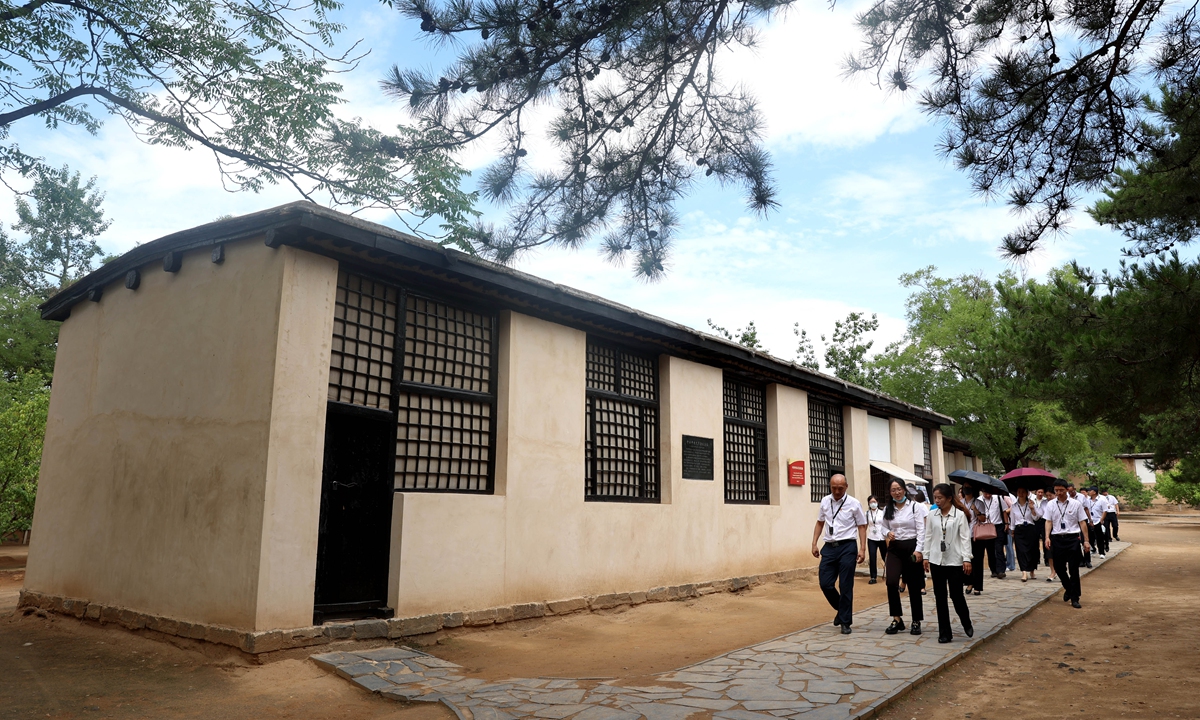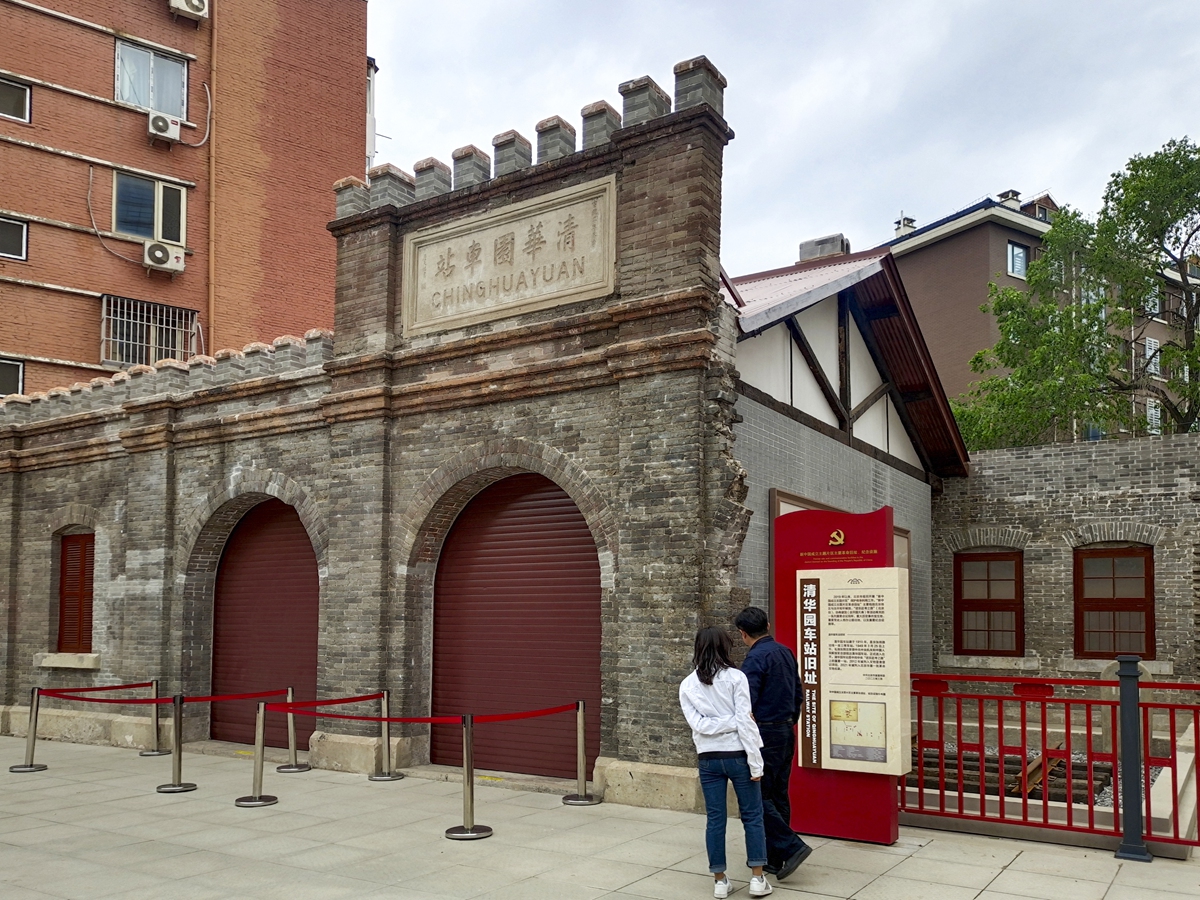
Tourists visit the former site of the CPC Central Committee in Xibaipo, Hebei Province. Photo: VCG
On March 23, 1949, the members of the Central Committee of the Communist Party of China (CPC) packed up and left Xibaipo, a sacred place for the then 28-year-long Communist struggle in North China's Hebei Province. Chairman Mao Zedong referred to the journey as
jinjing gankao, or "going for a big exam in the capital city," as they headed north to build the People's Republic of China in Beijing.
The route from the former base of the CPC Central Committee in Xibaipo to Shuangqing Villa (where Mao Zedong had worked and lived) in the Fragrant Hills (Xiang Shan) in Beijing witnessed the historical transition of the CPC from a revolutionary party to a ruling party.
Seventy-five years later, the cultural heritage bureaus of both Beijing and Hebei jointly held the opening ceremony of the revolutionary cultural relics theme tour on Monday. Seven important revolutionary sites along the route from Xibaipo to Beijing were connected, showcasing the achievements of the protection and utilization of red cultural relics.
Retrace revolutionary route At the former site of the Qinghuayuan railway station, where Mao and other CPC leaders arrived in Beijing from Xibaipo, a huge scroll unfolded, showing a winding route linking seven important locations: The travel route sites start from the CPC's last rural command post Xibaipo tucked away in the rolling Taihang Mountains, passing through Shulu Village in Hebei, the memorial site of Mao Zedong's residence before the CPC Central Committee entered Beijing, Zhuozhou railway station, Qinghuayuan railway station in Beijing and Yishou Hall in the Summer Palace, to the destination Shuangqing Villa in the Fragrant Hills.
Visitors can follow the route map to retrace the journey and reflect on the aspirations from the memories.
Inside the Xibaipo Memorial Hall, the 75th anniversary exhibition of
The CPC Central Committee Journey from Xibaipo to Beijing showcased over 300 precious historical photos and 54 cultural relics, comprehensively reviewing the history of the CPC Central Committee from Xibaipo to Beijing and the establishment of PRC through seven exhibiting units.
Zhou Yanzhi, director of the Exhibition and Preservation Department of the Xibaipo Memorial Hall, stated that many exhibits made their debut in this exhibition. "Through these warm historical 'puzzles,' we hope to restore more details of the journey to Beijing," said Zhou. On Monday, several sites and memorial halls along the route jointly launched the initiative of "protecting, inheriting, and utilizing cultural relics along the red tourism route," promoting the overall protection and innovative development of immovable cultural relics through the cultural relic-themed routes.
For experts, such themed tourism represents the integration of the overall protection of immovable cultural relics and the development of cultural tourism. "Red tourism has become a major option in today's cultural tourism landscape," Sun Jiashan, an associate researcher at the Central Academy of Culture and Tourism Administration, told the Global Times on Tuesday.

The former site of the Qinghuayuan railway station in Beijing Photo: VCG
Rise of red tourismRed tourism, which refers to visiting historical sites with a modern revolutionary legacy, has become increasingly popular among Chinese tourists in recent years.
During the Spring Festival holidays, red tourism emerged as a new highlight for holidaymakers, with attractions such as the Memorial Hall of the First National Congress of CPC in Shanghai, Xibaipo Memorial Hall, and the Former Residence of Zhou Enlai bustling with visitors.
In Mao's hometown Changsha, Central China's Hunan Province, the Orange Isle scenic spot, home to the giant statue of young Mao Zedong, saw 632,000 visitors during the Spring Festival holidays, a 44.63 percent year-on-year increase.
To attract tourists, some sites also embrace digitalization and smart technology, such as AR, to dynamically present red stories. While others try to adopt innovative promotional ways to engage with visitors.
For instance, starting March 16, a red-themed train from Shanghai to Jiaxing, Zhejiang Province, launched a series of red tourism routes. The train's exterior features a color scheme of red, gold, and green, blending red cultural elements with the quaint style of the 1920s. Two carriages have been transformed into red-themed functional areas, including a "train post office" and a "CPC Party history learning corner."
Activities such as quizzes on Party history, and singing revolutionary songs are conducted onboard. Additionally, railway cultural products and postcards will be randomly distributed, allowing passengers to immerse themselves in a red cultural atmosphere during their journey.
"These various forms of red tourism can not only engage young audiences, but also help promote the understanding and acceptance of mainstream values while unifying commercial and social value," Sun noted.
Li, 56, who has visited Yan'an, Xibaipo, and Jinggangshan, said he chose these locations because Chairman Mao once worked there, so he wanted to understand what those places were like during that time.
Nowadays, not only people like Li, born in the 1960s, but also many young people, who were born in the 1990s and 2000s, are visiting red tourism sites.
For example, Orange Isle in Changsha has become a must-visit destination for young travelers. On social media platforms, many share tips for visiting Orange Isle, including the best routes and photo angles. During a visit to Orange Isle in 2023, the GT reporter saw crowds of tourists seeking perfect photo angles, with some lining up to capture shots with the statue of young Mao Zedong.
"By connecting the old sites, we have better preserved cultural relics and related historical sites. And also through this connection, the revolutionary story from history is told more vividly, comprehensively, and integrally," Li Liangqi, director of the Cultural Relics Protection Department of the Beijing Municipal Bureau of Cultural Heritage, told the Global Times on Tuesday.